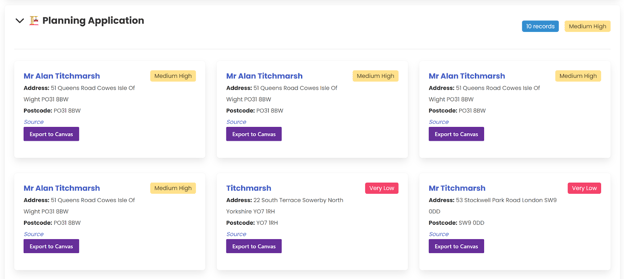When investigating people in the UK, no single dataset tells the whole story. Each source, whether it’s the electoral roll, business filings, planning applications, or local registers, offers just one piece of the puzzle. The key to effective OSINT is learning how to combine those fragments to build a coherent picture.
In this case study, we explore how publicly available data can be layered to confirm information and strengthen confidence in findings, using a real-world example currently in the public domain: broadcaster Alan Titchmarsh. His Hampshire home has appeared in both news articles and online discussions, providing an ethical, verifiable scenario to test how different UK datasets connect and corroborate each other.
Public Clues in Plain Sight
High-profile properties often enter the public domain through planning applications and property listing, which are reported in the news and casually mentioned on social media or forums.
A recent Reddit post identified a house in Holybourne, Alton as Alan Titchmarsh’s property. That claim was consistent with a Telegraph article discussing his Hampshire home and garden. The two public references make this a suitable example of how OSINT practitioners can piece together publicly available data responsibly.
With the subject and area identified, the next step was to test what could be uncovered using public UK datasets in Cradle.
Step One — Searching Narrow: Full Name and Full Postcode
The first search combined “Alan Titchmarsh” with the full postcode for the Holybourne property listed in the Reddit thread.
- Result: No direct match for Alan Titchmarsh on the electoral roll, a common occurrence for public figures who opt out of the edited register.
- Related finding: A business record for Alison Titchmarsh at the same Church Lane address. This immediately strengthens the location hypothesis, as OSINT investigators often confirm residences through family members or co-residents.

- Additional discovery: Planning data revealed an address in Cowes, Isle of Wight. This link is supported by a WalesOnline article noting that Titchmarsh spends part of his time on the island.

Even without a direct electoral roll match, these layered findings begin to build a coherent picture using multiple independent datasets.
Step Two — Broadening the Search
Next, the search criteria were widened. Instead of looking for the full name and postcode, we ran a search for “Titchmarsh” and partial postcode “GU34”.
This time, Camilla Titchmarsh appeared on the electoral roll, confirming a family link to the same area. The result demonstrates a key investigative principle: when initial parameters return limited results, adjusting your search breadth can surface related or corroborative data points that reinforce your findings.

Step Three — Cross-Referencing Public Data
With a growing list of addresses and related names, the next stage was to test alignment across different record types:
- Electoral roll: Family member confirmation (Camilla Titchmarsh).
- Company records: Family member confirmation (Alison Titchmarsh).
- Planning data: Address correlation and geographical validation.
- News sources: Public references to both properties in media and social posts.
Each dataset tells only part of the story, but when cross-referenced, they produce a consistent pattern, providing a key indicator of confidence in OSINT investigations.
Lessons for Investigators
This case study shows several important principles for anyone conducting UK-based OSINT or due diligence research:
- A missing dataset isn’t the end of the road.
The absence of a record, like an electoral roll entry, doesn’t mean the lead is invalid. Other datasets can fill the gaps.
- Broaden search parameters thoughtfully.
Adjusting from a full to a partial postcode or using only a surname can reveal family members or associated addresses.
- Corroboration builds confidence.
When structured records align with other web sources, the probability of accuracy increases substantially.
Understanding API Limitations
While reviewing connected data, a historical Companies House listing was located directly on the government website, once linked to the same Church Lane address. However, this record doesn’t currently appear in Cradle because the Companies House API excludes companies dissolved for more than six months.
This is a limitation of the public API. Many OSINT tools, including ours, depend on live data feeds that enforce age or activity restrictions. For practitioners, this highlights a crucial point: even public data sources have blind spots.
When the context appears incomplete, it’s worth checking the official Companies House register or archived datasets manually.
We’re aware that not showing dissolved records older than six months can occasionally omit relevant context, and we’re actively working to resolve this. OSINT practitioners can’t always allow for API constraints, which is why understanding how data is filtered before it reaches your platform is just as important as interpreting what you see on screen.
Finding Confidence in Fragmented Data
In this example, the electoral roll alone didn’t connect Alan Titchmarsh to the address for sale directly, but layering alternative public datasets, like planning records, electoral roll for relatives, and corroborative media coverage, provided a complete picture.
OSINT isn’t about finding one perfect dataset; it’s about combining multiple, imperfect ones to reach a confident conclusion.
Even where data access is limited by API constraints, understanding why those gaps exist allows practitioners to adapt their workflow and seek verification elsewhere.
Cradle continues to expand its public-record coverage to make that process easier, helping investigators link people, properties, and businesses across the UK, even when key datasets appear out of reach.